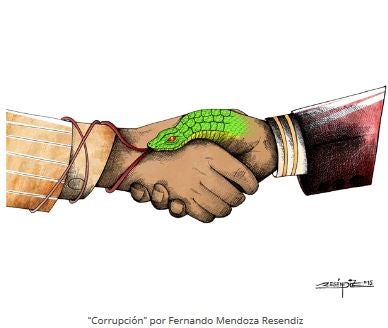Art Against Corruption

Twelve years ago, the United Nations General Assembly designated December 9 as “International Anti-Corruption Day.” Today, it seems that this measure has already achieved its purpose, at least in Latin America and the Caribbean where we have unquestionably increased our awareness of the disease. It is widely recognized that corruption undermines the sustainable development of countries, leads to violation of human rights, distorts markets, disturbs social cohesion and jeopardizes the effectiveness and credibility of public institutions, representing a threat to the legitimacy of the state.

Corruption is not a phenomenon exclusive to any region, country, culture or religion; on the contrary, it is global, and its manifestations are as vast as they are widespread. Probably because of the universality of the phenomenon, there is a tendency to oversimplify its nature. Paraphrasing Cheyanne Scharbatke-Church, corruption is like an impressionist painting by Signac: on the surface anyone can appreciate the image, but if we focus closely on it we will perceive that, in reality, there are thousands of little hidden dots.
It is well known that corruption is an endemic evil. But if we start analyzing it point by point, we may wonder why some countries are perceived as more corrupt than others. Is it because of inefficient institutions or public officials? Is it because of economic booms that give rise to greed? It is all these and much more. During the past two years, several governments in the region have been rocked by a series of corruption and impunity scandals which have pushed them to implement reforms and propose the creation of new institutions to counter the scourge. In Guatemala, even the president was removed for corruption.
The opposite of a corrupt government is obviously a good one and, in this respect, experts conclude that good governance goes well beyond reforms, punishments or the creation of new institutions. Good governance depends, among other things, on the existence in the political sphere of a small number of parties which are mature enough to propose long-term programs; on a professional legislative branch with capacity to negotiate and enforce agreements; and, as our expert Carlos Scartascini commented in a past blog, on the existence of a truly independent judiciary.
Common sense tells us that for good governance it is essential to have technically competent officials who do not abuse entrusted power for private gain.

This is where a key element against corruption appears: clientelism. “In much of Latin America and the Caribbean, clientelism is so widespread in the public administration that the bureaucrats who have been entrusted with critical aspects of national life – such as health, education and the economy – are often appointed more for their political value than for their professional competence.“ In other words, clientelism creates an environment conducive to corrupt practices. Public officials at all levels can find incentives to accept bribes or plunder the treasury, knowing they will be protected by clients higher up in the system. It is unusual to find a real system of checks and balances.
Clientelism is strongly correlated with corruption in the sense that it can create an unspoken pact of complicity between the executive, legislative and judiciary branches. A study by the Inter-American Development Bank found that 10 of the 18 Latin American countries have classically patronage-based bureaucracies. Lack of professionalism in public service and lack of transparency in the allocation of public offices are definitely “one more little dot” in the complex symptoms of the disease.
Speaking of art and corruption, to mark the International #AntiCorruptionDay at the IDB we held our cartoon contest “Towards a region with more integrity and transparency: images in the fight against corruption“ from which the illustrations in this blog are taken. Cartoonists from all over Latin America and the Caribbean joined in the effort to keep spreading the message against this evil, knowing that, although it sounds like a cliché, a picture is worth a thousand words.
Continuing with the metaphor of art and corruption, it is probably time for this day not to be just about creating a passive awareness of the phenomenon, but for analyzing and eliminating one by one the little dots that have shaped the image of “abominable” corruption.
Do you want to access more studies? Don’t forget to subscribe to our blog here.
Follow us on TwitterIDB_Thinks


Leave a Reply